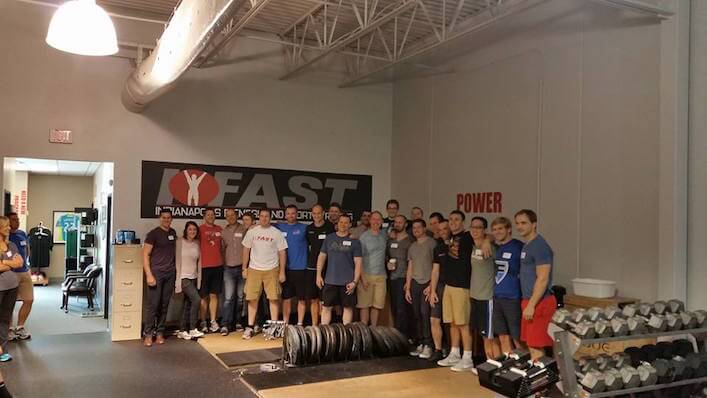Whenever I start prepping for seminars, I feel like my brain is one big, jumbled mess.
(Yes – even more jumbled than usual!)
I have my current thoughts/ideas/philosophies about training, but then I’m also “uptaking” a bunch of new material as well. It’s like taking a neat and tidy room, and then throwing a ton of stuff on the floor.
Quite simply, it takes some time to go in and sort all of that new stuff out and put it where it (ultimately) goes.
So as a direct reflection of where my brain is at right now, I’ve got a very random post for you today. Here’s a bunch of stuff that I’m thinking about when it comes to training. Enjoy!
- Feeling the whole foot allows our athletes to become pushers vs. pullers.
- One of our most important jobs as coaches is to help athletes understand and master their own center of gravity. Many (if not most) of our athletes are losing this battle.
- RDL’s are an awesome exercise – unless your hamstrings are already overstretched. In that case you’re probably better off doing integrated knee flexion exercises like glute-hams, ball leg curls, etc.
- 2-KB and safety bar front squats are officially my go-to squat exercises for athletes.
- But I still love back squats for myself. Sorry – not sorry.
- Mastering the breath can be one of the simplest, yet most influential things you do for your body (or that of your athletes).
- If you aren’t already, start programming more reaching into your programming. Here’s how to do it, and some exercises to help.
- If you have the time to do it, and the athlete is fit enough to get through it, a full Cooper’s test is vastly superior to a modified version.
- When going through return to play protocols, running may not be the best way to restore basic cardiovascular function.
- Movement quality is something that we can address to immediately increase resiliency. Conditioning may take a bit longer, but I would argue it’s no less valuable. Address both (and check out Joel’s new conditioning course as well. It’s going to be awesome).
- If your only assessment occurs on the first day when an athlete is fresh, you’re missing a big piece of the puzzle.
- Stop talking about muscles, and start thinking about the brain.
- But remember – the brain has to get it’s “feedback” from somewhere. Everything matters.
- Along these same lines, start thinking about how all of the body’s systems work together to promote harmony (or distress).
- I see tons of way we can improve today’s warm-ups. It’s more than just movements and stretches – think agility, balance, coordination, speed, skill development, etc.
- I still can’t express how important it is to teach your athletes to absorb force. Extension, abduction and external rotation are great – assuming you can flex, adduct and internally rotate when you need to.
- Have I mentioned lately how important abs are? If not, I’m going to take four hours to cover this topic in our pre-conference for the 2015 Physical Prep Summit. You should come!
- I’m still shocked at how poorly designed many team sports conditioning tests are. If your test doesn’t assess the athlete’s ability to produce energy in a sport-specific environment, what good is the test?
- For the first time in a long time, I’m genuinely excited about my own training and where it’s going. More on this soon.
- It’s boring, mundane and no one likes to do it, but half-kneeling work gives you some massive ROI. If you’re not including some form of half-kneeling work each week, give it a shot – I guarantee it will make a difference.
- Biomechanics are only part of the equation when someone gets injured. Dig a bit deeper and I bet you find a ton of “little” influences that led to one major event.
- I love the balance between assessment and program design. What I’ve found is that the more specific you get with your assessment, the more targeted you can get with the program design. The end result is a superior program.
- External cuing is absolutely fantastic for athletes performing high-speed/power/strength exercises. But I also feel there’s a time and place for internal cuing as well (i.e. resets, rehab, etc.).
- There’s a time and a place for (almost) anything.
- N=1. Always.
- One of my goals with the programs I write nowadays is to smooth things out. How do you smoothly transition from warm-up to training? Or on a more macro level, from an accumulation phase to an intensification phase?
- If you’re not surrounding yourself with people better than you, you’re ultimately going to limit your own abilities.
- You don’t become a better coach by reading a book. Learn the skills and techniques from the books, DVD’s, manuals, etc., but you have to get out there and do it. Make mistakes. You’ll be a better coach as a result.
- Regardless of what you originally came into this industry as, unless you coach powerlifters you’re not a “strength” coach. Physical preparation (i.e. all relevant physical qualities/traits) is really the name of the game.
- Don’t tell me your kid needs an hour of “speed and agility training” when he can’t skip or jump rope.
- Great training is all about principles. The more I learn about various aspects of training (speed, power, strength, conditioning) it all comes back to the same basic principles of movement training. Therefore, make it a job to master principles – not just learn about new tools.
Like I said, a bit random but there’s some good stuff in there, and I’ll be expanding on some of these topics in the coming weeks.
Plus, it’s short, so read it twice 🙂
Have a great week and thanks for reading!
All the best
MR

